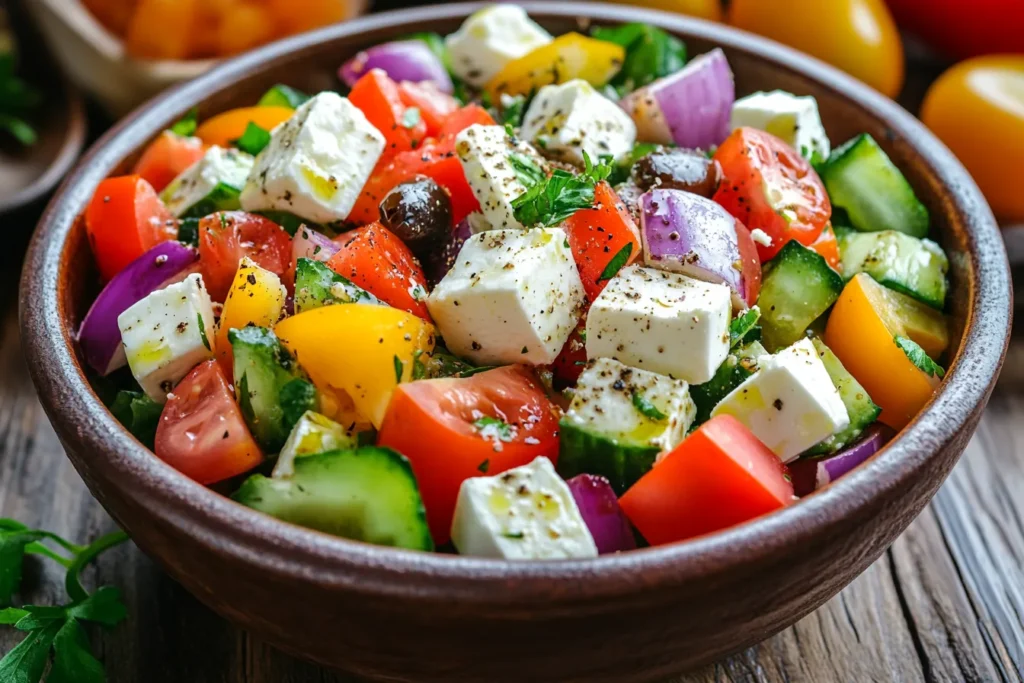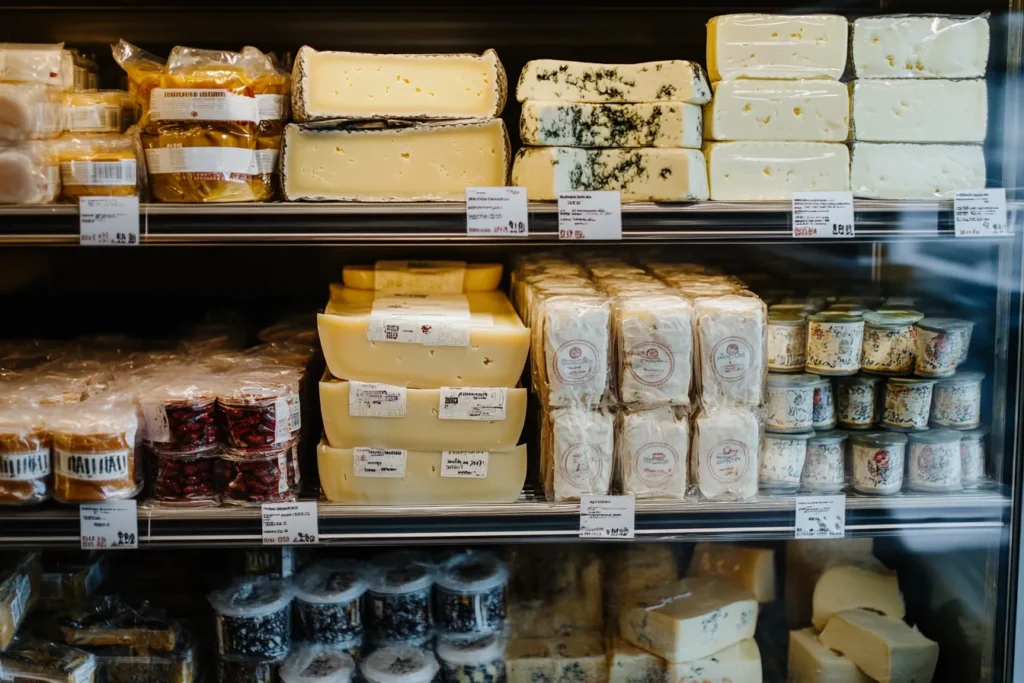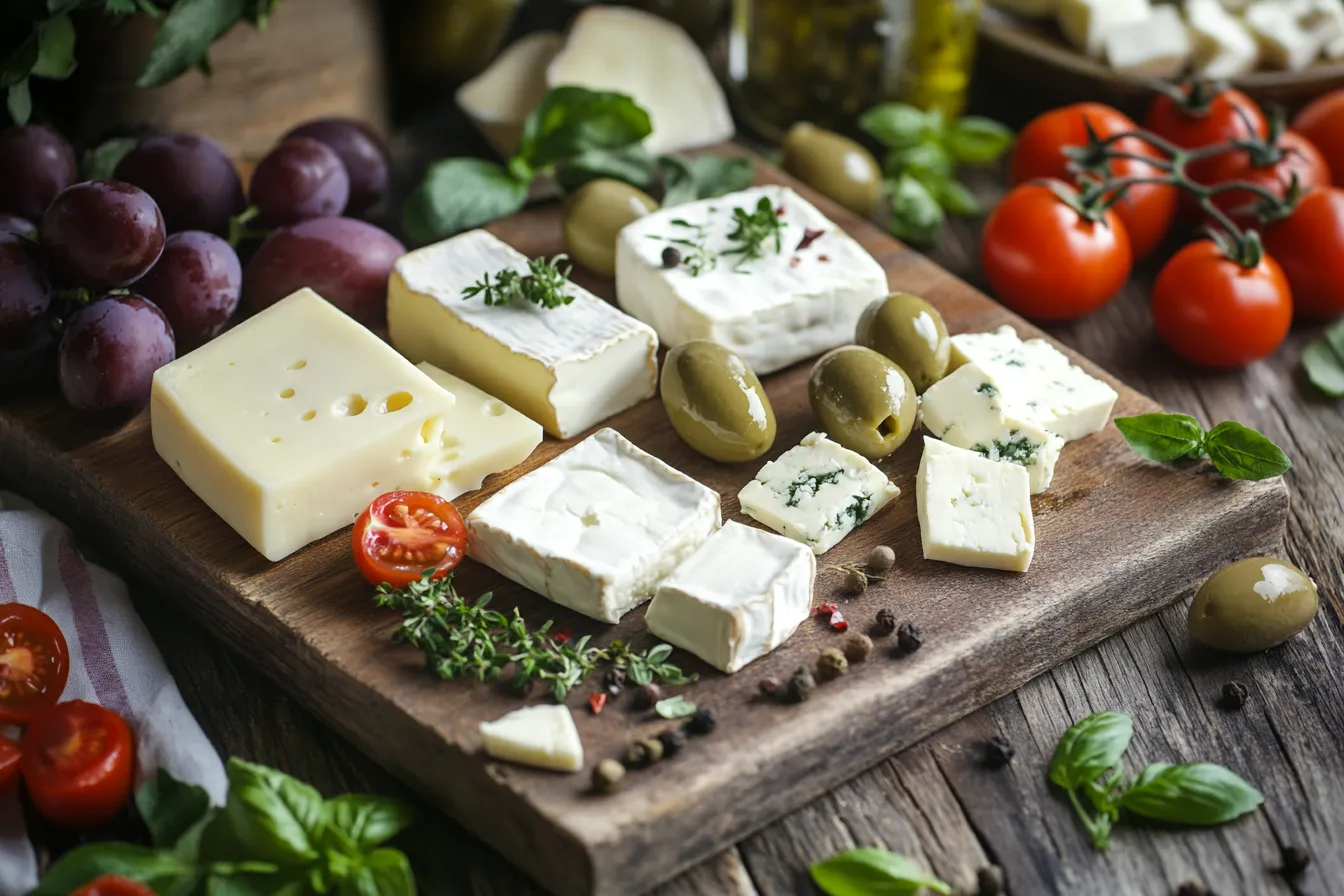Introduction
Greek cheese is more than just a delicious topping for salads it’s a culinary cornerstone that dates back thousands of years, offering a rich heritage and unmatched flavor profiles. From the crumbly, tangy magic of feta to the sizzling bite of saganaki, Greek cheeses have captured the hearts (and stomachs) of food lovers worldwide.
The Mediterranean region is known for its vibrant food culture, and cheese plays a starring role in Greek cuisine. Whether served raw, grilled, baked, or pan-seared, Greek cheese can elevate a simple dish into a mouthwatering experience. Many of these cheeses, like feta and kasseri, are also Protected Designation of Origin (PDO) products, ensuring authenticity and tradition in every bite.
Today, Greek cheese is more accessible than ever, showing up on charcuterie boards, in gourmet recipes, and even in health-conscious meal plans. With rising global demand and increased awareness of its health benefits and versatility, Greek cheese has become a trending topic in the culinary and wellness worlds alike.
This comprehensive guide explores everything you need to know about Greek cheese from its ancient origins and popular varieties to cooking tips, nutritional benefits, and shopping advice. Whether you’re a curious foodie, a health-conscious eater, or a home chef looking to up your game, this blog will give you all the flavorful details.
In the sections that follow, you’ll discover the most iconic Greek cheeses, traditional and modern ways to enjoy them, and expert advice on storing and selecting authentic products. You’ll also find answers to frequently asked questions and insights into the future of Greek cheese in the international food scene.
Let’s dive into the world of creamy textures, bold flavors, and centuries-old craftsmanship that define Greek cheese..What To Make With Ricotta Cheese

History and Origins of Greek Cheese
Ancient Greek Cheesemaking Traditions
Cheesemaking in Greece dates back to at least 4,000 years ago, as documented in ancient texts and mythology. In Homer’s Odyssey, the Cyclops Polyphemus is said to have made cheese from sheep’s milk, storing it in woven baskets. This tale isn’t just folklore it reflects early Greek methods of curdling and storing cheese using natural tools and environmental conditions.
In the early days, cheesemaking was largely a pastoral activity, carried out by shepherds in mountainous regions like Thessaly, Epirus, and the islands of the Aegean. These shepherds relied on goats and sheep the primary dairy animals in Greece due to the country’s rugged terrain and developed a variety of cheeses tailored to local climates and resources. This led to a rich diversity of regional cheeses with distinct textures and flavor profiles.
The use of rennet from lambs or kids, combined with natural acidification, formed the backbone of ancient Greek cheesemaking. Over time, techniques such as brining, aging in caves, and wrapping cheeses in herbs or grape leaves added layers of complexity.
Modern Evolution and Global Popularity
Fast-forward to today, and Greek cheese has gone global. The European Union granted feta its PDO (Protected Designation of Origin) status in 2002, legally recognizing its Greek roots and protecting it from imitation. Since then, many other varieties such as kasseri, manouri, and kefalograviera have followed suit.
Greek cheese now appears on restaurant menus, in gourmet stores, and in supermarkets around the world. Its rise is not only due to flavor but also to the growing appreciation for traditional, nutrient-rich, and authentic foods..Cottage Cheese Meals
Thanks to food tourism, social media, and cooking shows, dishes like saganaki and grilled halloumi have become popular internationally, driving interest in Greek dairy products. Greek cheese is no longer limited to Mediterranean diets—it’s now part of global wellness and gourmet food movements.
Types of Greek Cheese
Greece boasts over 60 varieties of cheese, each with its own local recipe, milk source, texture, and aging process. Below are some of the most celebrated types:
Feta Cheese – Greece’s Famous Brined Cheese
Feta is Greece’s best-known cheese and accounts for over 70% of the country’s cheese consumption. It is traditionally made from sheep’s milk or a mixture of sheep and goat’s milk, and it’s aged in wooden barrels or tin containers filled with brine. The result? A crumbly, salty, tangy cheese that is firm yet creamy.
Feta is a PDO product and can only be labeled as such if it’s produced in specific Greek regions using traditional methods. It’s typically used in salads like horiatiki (Greek village salad), in savory pastries like spanakopita, or as a table cheese drizzled with olive oil and oregano.
Kefalotyri and Kefalograviera
These hard cheeses are beloved for their firm texture and rich, salty taste. Kefalotyri is one of the oldest cheeses in Greece, often made from goat’s or sheep’s milk and aged for several months. It’s commonly used in grated form or fried as saganaki.
Kefalograviera is slightly milder and creamier than kefalotyri and is often enjoyed on cheese platters or paired with pasta. Both are excellent melting cheeses, which makes them ideal for baked dishes.
Halloumi and Saganaki
Though halloumi is often associated with Cyprus, it’s deeply rooted in Greek culinary culture. Made from sheep and goat’s milk, halloumi has a high melting point, allowing it to be grilled or fried without losing its shape. Its mild, slightly salty flavor makes it ideal for appetizers or main dishes.
Saganaki isn’t a cheese per se but a method of preparation frying cheese in a small pan. Cheeses like kefalotyri, graviera, or kasseri are commonly used. When fried, they form a golden crust while remaining soft inside. Often served with lemon and fresh bread, saganaki is a beloved Greek meze.
Manouri, Mizithra, and Other Classics
Manouri is a semi-soft whey cheese made from the leftover whey of feta production, enriched with cream. It has a mild, milky flavor and is often used in desserts or salads.
Mizithra, another whey cheese, can be fresh (sweet and soft) or aged (salty and dry). Fresh mizithra is used in pastries and as a breakfast cheese, while the aged version is grated over pasta.
Other regional cheeses include katiki, a creamy cheese from Domokos, and formaela from Arachova, known for its intense flavor and grilling capabilities..Cottage Cheese

How to Cook & Use Greek Cheese
Greek cheese isn’t just for topping salads it’s a versatile ingredient that brings rich flavor and texture to countless traditional and modern dishes. From sizzling appetizers to stuffed pastries and grilled delights, Greek cheeses shine in the kitchen. Below, we explore the best ways to cook with different types of Greek cheese and some must-try recipes.
Classic Saganaki – Pan-Seared Greek Cheese
Saganaki is one of the most iconic Greek appetizers and a shining example of how cheese can be the hero of a dish. It refers to the method of pan-frying cheese in a small two-handled skillet, also called a saganaki pan. The result? A crispy golden crust and a gooey, savory center.
To make saganaki, cheeses like kefalotyri, graviera, or kasseri are ideal due to their high melting points. Here’s a quick and classic method:
- Ingredients:
- A thick slice of kefalotyri or kasseri (about 1cm)
- All-purpose flour for coating
- Olive oil
- Lemon wedges for serving
- Instructions:
- Lightly rinse the cheese slice with water.
- Dredge it in flour, shaking off excess.
- Heat olive oil in a non-stick pan.
- Fry the cheese until golden brown on both sides.
- Serve immediately with a squeeze of lemon.
This simple dish is rich, salty, and satisfying perfect as a starter or a part of a meze platter. For variation, top with fig jam or honey and crushed pistachios.
Salads & Appetizers with Feta
Feta cheese is perhaps the most versatile of all Greek cheeses and can be enjoyed in both cold and hot dishes. In traditional Greek salad (horiatiki), a thick slab of feta sits atop ripe tomatoes, cucumbers, red onion, Kalamata olives, and green peppers, seasoned with oregano and olive oil.
Other popular feta-based appetizers and dishes include:
- Dakos: A Cretan dish made with barley rusks, chopped tomatoes, olive oil, and crumbled feta.
- Spanakopita: A savory spinach and feta pie wrapped in layers of crisp phyllo pastry.
- Tirokafteri: A spicy whipped feta dip made with roasted peppers, olive oil, and garlic perfect for dipping with pita.
You can also bake feta with cherry tomatoes and garlic (a viral trend), or wrap it in phyllo, fry it, and drizzle with honey for a sweet-and-savory delight.
Cooking with Halloumi and Grilling Tips
Halloumi stands out for its grillable nature. Its firm texture and high melting point make it perfect for searing, barbecuing, or even air-frying. Here’s how to make the most of halloumi:
- Slice it into ½-inch thick pieces.
- Lightly brush with olive oil.
- Grill or pan-fry for 2–3 minutes per side until golden.
Serve grilled halloumi with watermelon, fresh mint, or a citrus dressing for a refreshing summer dish. It’s also excellent in sandwiches, grain bowls, or Mediterranean-inspired wraps.
For something fancier, stuff halloumi into skewers with vegetables or wrap it in prosciutto before grilling. The cheese’s chewy, salty bite balances well with sweet or acidic ingredients like grapes, balsamic glaze, or pomegranate molasses.
Additional Cooking Tips:
- Avoid over-salting: Many Greek cheeses are already brined.
- Mind the melt: Feta melts slightly, while halloumi and kefalotyri hold their shape.
- Pair with herbs: Oregano, thyme, and mint elevate flavor.
- Use in layering: Feta or manouri works great in lasagna-style dishes like pastitsio.
From appetizers to main courses and even desserts, Greek cheese adds flavor, history, and authenticity to your meals.

Nutritional Benefits & Dietary Considerations
Greek cheese is more than just flavorful it also packs a nutritional punch. From protein content to essential minerals like calcium and phosphorus, these cheeses can be part of a balanced and health-supportive diet. However, like all cheeses, they should be enjoyed mindfully, especially for those with dietary restrictions.
Macronutrient Profile of Feta, Halloumi, and Other Greek Cheeses
Different types of Greek cheese offer varied nutritional profiles depending on their fat content, aging process, and milk source. Here’s a breakdown of the nutritional content for some of the most popular Greek cheeses (per 100g average serving):
| Cheese Type | Calories | Protein | Fat | Carbs | Sodium | Calcium |
|---|---|---|---|---|---|---|
| Feta (sheep/goat) | ~265 kcal | 14g | 21g | 4g | 1100mg | 490mg |
| Halloumi | ~320 kcal | 21g | 25g | 2g | 800mg | 700mg |
| Manouri | ~420 kcal | 12g | 35g | 3g | 500mg | 600mg |
| Kefalotyri | ~400 kcal | 27g | 32g | 1g | 1200mg | 650mg |
| Graviera | ~420 kcal | 25g | 34g | 2g | 1000mg | 700mg |
As you can see, Greek cheeses are generally high in protein and fat especially saturated fat making them quite energy-dense. However, they’re also excellent sources of:
- Calcium: Supports bone health and muscle function.
- Phosphorus: Helps with energy production and DNA repair.
- Vitamin A & B12: Essential for vision, immunity, and red blood cell production.
Their high protein content makes them especially satiating, contributing to feelings of fullness, which can aid in weight control when consumed in moderation.
Who Should Avoid or Moderate Greek Cheese Intake
While Greek cheese offers many health perks, certain individuals should consume it in moderation or opt for specific types.
- Lactose-Intolerant Individuals: Aged Greek cheeses like kefalotyri and graviera tend to have lower lactose levels than fresh ones, but they may still cause discomfort in sensitive people. Feta, made from sheep/goat milk, often causes fewer issues than cow’s milk cheeses.
- Low-Sodium Diets: Many Greek cheeses are brined (especially feta and halloumi), resulting in high sodium levels. One slice of feta can contain up to 400–500 mg of sodium. Choosing low-sodium or rinsed versions may help mitigate this.
- Heart Health Concerns: Due to high saturated fat, overconsumption of full-fat cheeses may increase cholesterol levels. Consider portion control or opt for lighter cheeses like fresh mizithra or manouri.
- Weight Management: Cheeses like manouri are rich and high in calories due to added cream. For those watching their weight, using feta or grilled halloumi in controlled portions is preferable.
Best Practices for Healthy Cheese Consumption:
- Watch portion size: Aim for 30–40g per serving.
- Balance with veggies: Combine with salads or grilled vegetables for a nutrient-dense plate.
- Choose aged varieties: These often contain more probiotics and less lactose.
- Limit processed pairings: Skip heavily processed crackers and opt for olives, tomatoes, or whole grains.
Greek cheese can be a flavorful, nutritious addition to your diet as long as it’s consumed mindfully. It’s not about avoiding cheese, but about knowing which types fit your nutritional needs.
External Link Reference: For deeper reading on cheese’s health impacts, see this study on the nutritional value of cheese.

How to Buy & Store Greek Cheese
With so many varieties of Greek cheese available, buying the right one can feel overwhelming especially if you’re trying to spot authentic, high-quality products. On top of that, proper storage is key to maintaining flavor, texture, and food safety. In this section, we’ll guide you on where to buy Greek cheese, how to ensure it’s genuine, and how to store it effectively at home.
Recognizing Authentic Greek Cheese Labels
When shopping for Greek cheese, especially abroad, it’s essential to ensure you’re purchasing the real deal not an imitation. The most reliable way to do this is by checking for the PDO label (Protected Designation of Origin), which is a guarantee of authenticity.
What is a PDO Cheese?
A PDO designation means the cheese is produced, processed, and prepared in a specific geographical area using recognized know-how. For Greek cheese, this ensures:
- The cheese is made in Greece using traditional methods.
- It uses local sheep or goat milk (never cow’s milk in the case of feta).
- It maintains the specific texture, flavor, and quality defined by Greek standards.
Examples of Greek PDO Cheeses Include:
- Feta (recognized as PDO since 2002)
- Kasseri
- Kefalotyri
- Manouri
- Formaela Arachovas
How to Identify Authentic Greek Cheese:
- Look for the PDO logo – Usually red and yellow with the EU stars.
- Read the label – It should mention “Product of Greece” and specify the region.
- Check the milk source – Authentic Greek cheeses typically use goat’s or sheep’s milk.
- Avoid plastic containers without labeling – Especially in bulk bins or local markets that can’t verify origin.
External Link Reference: To learn more, refer to the official PDO Feta regulations.
Storing Brined Cheeses vs. Aged Cheeses
Storing Greek cheese correctly helps preserve its unique flavor, texture, and shelf-life. Different types require different storage conditions depending on moisture content and aging level.
How to Store Brined Cheeses (like Feta and Halloumi):
- Keep in Brine: If your feta comes in brine, leave it submerged in its original container. This keeps it moist, flavorful, and fresh.
- DIY Brine: If needed, you can make your own brine using 1 tbsp of salt per cup of water.
- Fridge Temp: Store in the coldest part of the fridge (around 2–4°C / 35–39°F).
- Lifespan: Typically 3–4 weeks after opening. Always check for off smells or slime.
Storing Vacuum-Packed Cheeses:
- Once opened, wrap in wax paper or parchment (not plastic wrap) and place in a sealed container to avoid mold or excessive drying.
How to Store Aged Cheeses (like Kefalotyri, Graviera, Manouri):
- Wrap Properly: Use cheese paper or parchment paper followed by foil to maintain moisture without trapping condensation.
- Fridge Life: These cheeses can last up to 6 weeks if stored well, and often improve in flavor over time.
- Freezing: While not ideal, hard cheeses can be frozen. Just note that texture may become crumbly upon thawing. Feta and fresh cheeses do not freeze well.
Buying Tips for Greek Cheese:
- Buy from reputable sources: Greek markets, Mediterranean delis, or specialty cheese shops.
- Avoid pre-crumbled feta: These often contain anti-caking agents and lack the authentic texture and flavor.
- Opt for blocks in brine: They retain moisture better and offer superior taste.
Greek cheese is best enjoyed fresh and properly stored to maintain its integrity. Once you’ve tasted authentic feta or freshly grilled halloumi, you’ll never go back to mass-produced imitations.
FAQ
Can Greek cheese be vegan-friendly?
Traditional Greek cheese is made from animal milk (usually sheep or goat), so it’s not vegan. However, due to demand, there are now plant-based “Greek-style” feta alternatives made from coconut oil, tofu, or nuts. These mimic the texture but vary in taste. Be sure to check labels carefully if you’re looking for authentic dairy-free options.
Is Greek cheese good for weight loss?
Greek cheeses like feta or halloumi can be incorporated into a weight loss plan when eaten in moderation. They are high in protein and fat, which promotes satiety. However, due to their calorie density, it’s important to control portions. Pairing cheese with vegetables and whole grains can create balanced, filling meals.
How long does Greek cheese last?
Shelf life depends on the type and how it’s stored:
- Brined cheeses (like feta): Up to 4 weeks in the fridge, if submerged in brine.
- Aged cheeses (like kefalotyri): Can last 4–6 weeks if wrapped properly.
- Fresh cheeses (like mizithra): Shorter shelf life consume within 5–7 days of opening.
Can you freeze Greek cheese?
Hard cheeses like kefalotyri and graviera can be frozen with minimal texture loss. Feta can be frozen, but its texture may become crumbly and less creamy. Always wrap tightly in foil or freezer bags and thaw slowly in the fridge.
What pairs well with Greek cheese?
Greek cheese pairs beautifully with:
- Fresh fruits (figs, watermelon, grapes)
- Honey or balsamic glaze
- Kalamata olives and roasted peppers
- Dry white wines, ouzo, or retsina
These combinations enhance the salty, tangy, or creamy notes of the cheese and provide contrast for a more complex flavor profile.
Can I grill feta directly or does it melt?
Feta generally softens and melts under high heat, but thicker blocks or foil-wrapped feta can be grilled or baked. For grilling, choose firmer varieties and wrap them in foil to prevent crumbling. Alternatively, try grilling halloumi or kefalotyri for better texture retention.
Conclusion & Final Thoughts
Greek cheese is more than a delicious food it’s a symbol of Greek heritage, craftsmanship, and tradition that has stood the test of time. Whether you’re savoring a creamy bite of feta in a fresh salad or searing a slice of kefalotyri for a crispy saganaki, each bite brings centuries of culture and flavor to your plate.
From its humble pastoral origins to its current status as a global gourmet trend, Greek cheese continues to win over food lovers around the world. With so many varieties to explore, there’s truly something for everyone whether you’re a curious cook, a health-conscious eater, or a Mediterranean cuisine enthusiast.
By understanding the different types, their nutritional profiles, cooking methods, and authentic origins, you can enjoy Greek cheese in its truest form. Just remember: look for PDO labels, store it properly, and don’t be afraid to experiment with pairings and recipes.
So next time you’re at the grocery store or planning a Mediterranean dinner night, consider adding a block of real Greek cheese to your cart you won’t regret it.

Name: Greek Cheese – Saganaki (Pan-Seared Greek Cheese)
Ingredients
Equipment
Method
- Instructions:
- Lightly rinse the cheese slice under cool water. Pat it dry slightly but leave some moisture.
- Dredge the cheese in the flour, coating it evenly on all sides. Shake off excess.
- Heat olive oil in a skillet over medium-high heat until shimmering.
- Carefully place the cheese in the pan and fry for 2–3 minutes per side, or until golden brown and crispy.
- Remove from the pan and place on paper towels to drain excess oil.
- Serve immediately with lemon wedges. Squeeze fresh lemon juice over the top just before eating.
Notes
Best served fresh and hot. Can be paired with a side of fresh pita, olives, or a drizzle of honey for a sweet-savory twist. Use firm, semi-hard cheeses like graviera or kefalograviera if kefalotyri is unavailable. Avoid soft cheeses like manouri or mizithra—they’ll melt too quickly and won’t hold shape.
